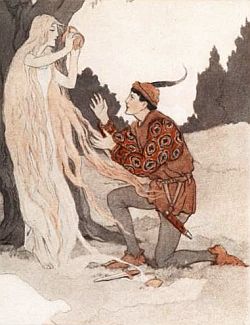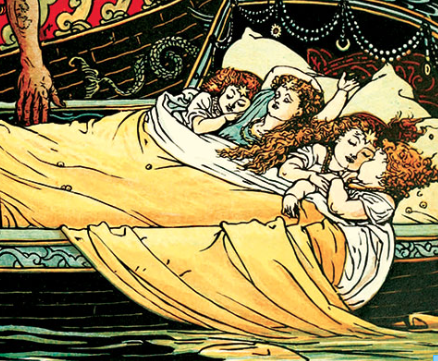|
Italo Calvino called the story of "The Love for Three Oranges" uniquely Italian; variants are widespread across the world. There are lots of different familiar motifs here. The red-and-white maiden, the woman inside a plant, and the false bride.
Calvino himself published two versions of this story: the more classical "The Love of the Three Pomegranates" (from Abruzzi) and a more unusual variant, "The Little Shepherd" (from Liguria). A more accurate translation of the title would be "The Shepherd who never grew" (Il pastore che non cresceva mai). It was originally collected by P. E. Guarnerio in 1892. A little shepherd boy plays a mean prank on a poultry dealer, who curses him "You shall get no bigger until you've found lovely Bargaglina of the three singing apples!" When her curse comes true, he sets out to find Bargaglina. He encounters a little lady in a walnut shell and a little lady bathing in an eggshell, who bid him lift up their eyelids, and a man collecting fog in a bag. None know of Bargaglina or the singing apples, but they give him a stone, a comb, and a pocketful of fog. He meets a miller (who is a talking fox), who tells him to go to a house where he'll find a crystal cage, hung with bells and containing the singing apples. But he must watch out for an old woman who guards them and sleeps with her eyes open. Sure enough, he finds the house and is able to steal the cage. Awakened by the bells, the old woman sends squadrons of soldiers after him, but he throws back the stone, comb and fog, which turn into mountains and obstacles. The shepherd, now safe, cuts an apple in half. He hears a voice telling him to be gentle. He eats half the apple and puts the other in his pocket. When he later reaches into his pocket for the rest of the apple, he finds instead a tiny, tiny lady. "I'm lovely Bargaglina," she said, "and I like cake. Go get me a cake, I'm famished." I really like Bargaglina, you guys. He places her on the edge of a nearby well, and goes to get a cake. Meanwhile, a servant named Ugly Slave visits the well for water. Seeing the extraordinarily beautiful Bargaglina, she grows envious and angry, and throws her into the well. The shepherd is heartbroken to find Bargaglina missing, but one day his mother draws water from the well and finds a fish in her bucket. They eat the fish and throw the bones out the window; from the bones grow a tree, which the shepherd cuts down for firewood. By this point his mother has died, but when he comes home from the pasture, he finds that someone has been doing the housework. One day he hides to see what's happening, and sees a resurrected Bargaglina emerge from the woodpile. She explains her transformation sequence, and the pair soon grow to normal size. They marry with a big feast, and "I was there, under the table. They threw me a bone, which hit me on the nose and stuck for good." Why the character is named Bargaglina, I don't know. An article on biochemistry mentions this story and explains that Bargaglina is the "nickname of a young woman born and raised in Bargaglina" (Trapani 50). I think this refers to Bargagli, a city in Genoa. Its name may come from the name of the Bergalli people (mountaineers), which is from the Ligurian base bergo (mountain). This is a pretty unique variant of "The Three Oranges" tale. The hero here is a peasant, rather than the usual prince. And yes, it's about apples rather than oranges. The earliest known version of this story is "The Three Citrons" in the Pentamerone. At the time it was published, citrus fruits were frequently identified with the golden apples of the Garden of the Hesperides from Greek mythology. Like the citron, the apples were guarded carefully and retrieving them was an arduous task. These fruits were associated with love and beauty, as in the myths of Aphrodite, Paris, and Helen, or Atalanta and Hippomenes. Basile contrasts the sour yellow citron with the milk-white, strawberry-sweet maiden who emerges from it. There is a strong emphasis on her white and red color. She has “a whiteness beyond all imagination,” driven home further by her rivalry with a black woman, and later when she becomes a white dove. Calvino mentions “forty other Italian versions” including nuts like "a walnut, a hazelnut, and a chestnut" or such fruits as “watermelons, lemons, oranges, apples, pomegranates, or melangole (which means in some places ‘oranges,’ in others ‘bitter oranges’)” (738). Orange trees must be cultivated, which meant they came with a connotation of civilization. The fruit itself was associated with many pleasant things, being both beautiful and delicious, and “the maidens who come out of them share in the mystique of the fruit” (Goldberg 191). In "The Little Shepherd," of course, the fruit are simply apples. (In "Tsarevitch Ivan, the Firebird and the Gray Wolf," the golden apples are also kept in a cage covered in bells.) There is a running theme throughout "The Little Shepherd" of unusual eyelids. Both the old people with drooping eyelids and the monster who sleeps with its eyes open are common motifs; drooping eyelids or eyebrows indicate extreme old age. This scene is usually a chance for the hero to showcase his kindness to others. There are some Celtic or Slavic tales where monsters have eyelids that must be propped up. The “reversed eyes” of the old witch create a “topsy-turvy" effect at this dangerous portion of the tale (Goldberg 129-131). The shepherd finds Bargaglina in the first apple he opens. This differs from many tales, where the prince finds a maiden in each fruit, and is supposed to have water ready when he opens them. However, when he opens the first fruit, a fairy emerges so beautiful that he forgets to give her water, and she either vanishes or dies in his arms. Only on the third fruit does he get it right, being next to a well. In some versions, the maidens ask for both bread and water. In "The Little Shepherd," the need for water is gone. Bargaglina still requests food, but there is no urgency here. After watering the fairy, the prince usually tells her to wait in a tree by the well while he goes to get proper clothing, tell his mother, fetch a carriage, or some other errand. (In the Pentamerone, the implication is that she's naked.) At this point, the tale takes a swift turn into "WHOA is this racist." A slave comes to fetch water from the well. She is identified as black, Moorish, a Saracen, or a gypsy. She is markedly hideous, and switches between stupid or cunning depending on what the story needs. Usually, she mistakes the fairy's reflection in the well for her own and declares herself too pretty to serve; when she realizes the truth, she grows crafty. She may stab the citron-girl with a pin, causing her to become a bird, or push her into the well, causing her to become a fish. Then she takes the girl's place and pretends to have been transformed - and hey, the prince just saw a woman appear out of an orange, so there's not much room to be skeptical. So the prince goes home with the wrong bride. "The Little Shepherd" gives no clues to the slave's appearance or nationality, referring to her only as Ugly Slave. Also, the well in The Little Shepherd feels like an orphaned remnant of the more well-known tale. There is no need for Bargaglina to have water. The slave does not mistake Bargaglina's reflection for her own. The well is only there so that she can throw Bargaglina in. After this, the slave departs from the tale, never to be heard from again. No false-bride narrative here. Although the heroine was originally difficult to keep alive, she becomes impossible to permanently kill, and is finally reunited with the prince. (Or in this case, the shepherd.) The motif of the reincarnation/transformation cycle dates back to the oldest known fairytale, the ancient Egyptian “Two Brothers.” These tales always seem to raise more questions than they answer. For instance, in "The Three Citrons," the wounded citron-girl becomes a dove, the dove dies, its feathers grow into a new tree, and the prince cuts open the citrons and sees the three fairies emerge all over again. Wouldn't you know it, the last girl is the same one he lost. As Martha Atelia Prince says, "where did the first two fairies come from? how did the princess get back into the citrus? and what happened to the enchanted pin?" (34) I can follow that up with questions for "The Little Shepherd": why does Bargaglina need to hide in the woodpile? Where did she get her name? And what happened to the other two apples? Overall, though, it's a weird and fun little tale. SOURCES
Other Variants of this tale
0 Comments
The person with a star, sun or moon on their face appears in several different tale types. However, depending on the tale, the details are a little baffling. What does having a star on your forehead even look like? Is it a literal star? Is it some kind of crown? Is it a birthmark shaped like a star?
The unusually-decorated girl appears in The Twelve Brothers (Germany), "The unnatural mother and the girl with a star on her forehead" (Mozambique), and The Maiden with the Rose on her Forehead (Portugual). In some versions of Aarne-Thompson-Uther type 850, "The Birthmarks of the Princess," she has birthmarks shaped like stars, suns, or moons. Sometimes, in the tale of "The Kind and Unkind Girls," the star is a reward given to a generous young woman. Her selfish and greedy sister receives horns, a donkey's tail, or some other ugly object on her forehead. I read one where it was a sausage. Examples of this variation include:
The last tale type that is well-known for the forehead-star is ATU type 707: The Three Golden Children. A woman gives birth to marvelous children, who have unusually shiny characteristics.
The star functions as a tangible sign of royalty and/or virtue. If a color is given, it is usually gold. Golden hair or skin can appear in similar roles, instantly marking someone as beautiful and extraordinary. FURTHER READING AARNE-THOMPSON MOTIFS
|
About
Researching folktales and fairies, with a focus on common tale types. Archives
July 2024
Categories
All
|
Writing in Margins


 RSS Feed
RSS Feed
